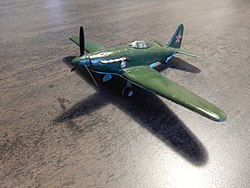Sukhoi Su-1
| Sukhoi Su-1 / Su-3 | |
|---|---|
 Model of the Su-3 |
|
| Type: | High altitude fighter |
| Design country: | |
| Manufacturer: | |
| First flight: |
June 15, 1940 |
| Number of pieces: |
2 prototypes |
Sukhoi Su-1 ( Russian Сухой Су-1 ) is the name of a Soviet high-altitude fighter from the Second World War .
development
The Su-1 was created from 1939 onwards as a result of a tender for a fighter aircraft for high altitudes as a competition design for the MiG-1 . She was the first independent design founded in the same year construction office of Pavel Sukhoi , which until then for Andrei Tupolev had worked. He designed the project I-330 (I stands for "Istrebitel", fighter aircraft) as a cantilever low- wing aircraft in composite construction with a relatively large wingspan. The fuselage consisted of a wooden structure with plywood planking. The wings were given a slight upward bend and were made entirely of metal except for the rudders. The main landing gear wheels turned 90 ° backwards into the wings. As an alternative to the AM-35A altitude engine used in the MiG-1 , Suchoi chose an M-105P designed for medium altitudes , which he equipped with two TK-2 turbochargers (for "turbo compressor").
Trials began on June 15, 1940. An impressive top speed of 641 km / h at an altitude of 10,000 meters was achieved. However, the experiments had to be interrupted because of the evacuation of the development office to Novosibirsk due to the German advance . The Su-1 suffered severe damage during transport. In 1942 a second prototype was therefore created with the designation I-360 or Su-3 . Mostly identical to the Su-1, but had a reduced wingspan, which reduced the wing area by two square meters. It was tested until 1943, but since it had become clear in the meantime that the German air force did not have a significant number of high-altitude bombers, no aircraft was needed to intercept German units flying high. In general, the rare bombings by individual high-altitude bombers from great heights turned out to be completely inefficient, imprecise and useless. The few high-altitude reconnaissance aircraft of the German Air Force were extremely rare and, due to the lack of high-altitude radar, could not be located and hardly combated. The program was therefore discontinued and the scarce resources were redistributed elsewhere. The aircraft itself was judged very positively and was constructively a success, but since there were no opponents in the envisaged range of operations and the aircraft in the lower airspace, in which the air battles took place, was not superior to the current models, series production was waived.
Technical specifications
| Parameter | Su-1 (I-330) | Su-3 (I-360) |
|---|---|---|
| Conception | High altitude interceptor aircraft | |
| Manufacturer | OKB Sukhoi | |
| crew | 1 pilot | |
| span | 11.5 m | 10.1 m |
| length | 8.42 m | |
| Wing area | 19.0 m² | 17.0 m² |
| Empty mass | 2,459 kg | 2,480 kg |
| Takeoff mass | 2,875 kg | 2,860 kg |
| drive | a liquid-cooled V12 engine Klimow M-105 with two TK-2 turbochargers | |
| power | 810 kW (1,101 hp) | |
| Top speed | 641 km / h at an altitude of 10,000 m | 638 km / h at an altitude of 10,000 m |
| Ascent time to 5,000 m | 4.9 min | 5.5 min |
| Summit height | 12,500 m | 11,900 m |
| Range | 720 km | 700 km |
| Armament | ? | a 23 mm cannon in the propeller shaft two 7.62 mm machine guns above the engine |
literature
- Manfred Jurleit: Suchoj Su-1 / Su-3 (USSR) . In: Fliegerrevue . No. 4/1980 (326) . Military Publishing House , Berlin, p. 178 .
Web links
- Drawing (three-sided view). Retrieved July 9, 2016 .